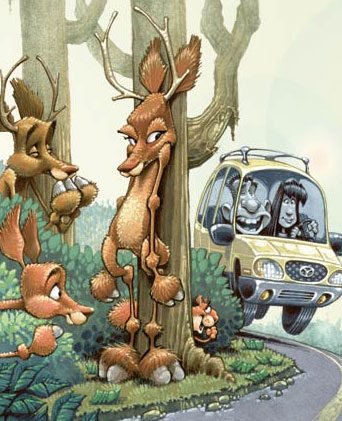Want the latest retirement plan adviser news and insights? Sign up for PLANADVISER newsletters.
Deer Not as Dainty as They Look
The eighth-largest auto insurance provider released figures that show animal-vehicle collisions increased seven percent from 2008 to 2009. However, the National Highway Traffic Safety Administration (NHTSA) also has data that show the number of fatalities and injuries from these accidents has decreased.
Fall is breeding season for deer and they tend to become most active in November, says USAA. Last year, 69% more claims were filed for animal-vehicle collisions during the fall than in the spring.
Collisions with animals are also costly, with average claims of $2,886 in 2009, according to USAA. They can also be deadly. The Insurance Institute for Highway Safety (IIHS) says that the number of human deaths from collisions with animals rose nearly 19% between 2001 and 2008, from 177 to 210.
“These findings remind motorists to be extra vigilant of deer during the fall, particularly during the dawn and dusk hours when they are looking for food,” said Ken Rosen, USAA’s senior vice president of claims. “We want motorists to stay safe no matter where the road takes them this fall.”
In 2009, West Virginia had the highest frequency rate of animal-vehicle collisions, according to USAA. The 10 states with the highest occurrences were:
- West Virginia
- South Dakota
- Iowa
- Montana
- Michigan
- Wyoming
- North Dakota
- Wisconsin
- Pennsylvania
- Mississippi
USAA offers the following tips to stay safe on the roads this season:
- Keep the six D’s in mind – Deer are most active at dawn and dusk so drive defensively during those hours. Stay off your cell phone and keep your seat belt fastened. IIHS says that most animal-vehicle collision deaths wouldn’t have occurred if motorists used seat belts and motorcyclists wore helmets.
- Watch the signs – Deer crossing signs designate popular deer crossing locations. Slow down when you see the signs, and be on the lookout for deer herds after you’ve seen one deer – they seldom travel alone.
- Brake for deer – Honking can sometimes be used to prevent deer from running into traffic, but deer are unpredictable. Safety experts recommend braking firmly and not swerving to avoid the deer. While you may be tempted to use your high-beam headlights when a deer is directly in front of you, they could cause a deer to stop in its tracks rather than running to safety just “like a deer in the headlights.” Braking firmly is the best line of defense.
- Stay put if you strike a deer – Do not get out of the vehicle to inspect the animal. It could still be alive and could cause injury. It’s best to contact local authorities should the animal be blocking potential traffic. For vehicle assistance, USAA members can receive immediate accident and roadside assistance through their iPhone and AndroidTM phones via USAA’s mobile app. Members can file a claim online at www.usaa.com/claims or by calling 1-800-531-USAA (8722).
